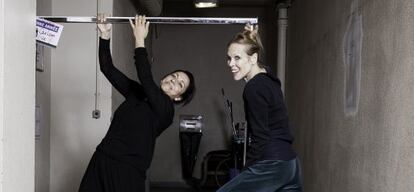Dancing to a universal rhythm
Flamenco and contemporary choreography unite for a unique show in Paris

Blonde, blue-eyed, tall and thin like a reed, Carolyn Carlson runs around on stage barefoot, while Eva Yerbabuena - black hair, dark eyes, average height - picks up her skirt and brings down the heels of her flamenco shoes in time with the siguiriya performed at a blues tempo by guitarist Paco Jarana and singer José Valencia. These two women could not be more different: one is a contemporary choreographer, the other is a bailaora , a flamenco dancer. Yerbabuena is shy and Carlson is a force of nature; neither speaks the other's language, yet they bond like sisters. On the stage, their movements sometimes come together, are sometimes complementary, and often reflect each other as though they were standing in front of an ironic mirror.
They have been rehearsing for two days and dreaming for several months about this moment: Carlson and Yerbabuena, together on Wednesday at the Théâtre National de Chaillot, for the first Paris Flamenco Biennale.
The legendary dancer, choreographer and poet from Oakland and the prestigious flamenco dancer are performing together for the first time in the city in which, back in the 1920s, Vicente Escudero invented Cubist dance and moved to the beat of a two-engine machine. The director of the Chaillot, former dancer Didier Deschamps, is very familiar with flamenco's avant-garde tradition and that is why he made room for a dialogue between artists from different disciplines. Besides this female duet that combines flamenco, blues and contemporary music, there will be another, all-male performance by Andrés Marín and Kader Attou.
Carolyn's way of expressing herself makes me overcome my shyness"
Yerbabuena, who has performed all over the world, says she met Carolyn during a Venice Biennale. "Carolyn is different because of the way she moves and her understanding of rhythm," she says. "She's on a different speed, a different internal clock. Her dancing is joyful, childish at times, but it has something to do with flamenco because it connects with the less tragic part of ourselves, with that tendency we have of laughing at our own troubles."
Meanwhile, Carlson explains that the really incredible thing about flamenco is its pride, "that vertical presence, the fire, even when it is low. It is interesting to dance with Eva because hands are my specialty, moving them is my world, hands are universal, and hers are very special, different to all others."
Eva Yerbabuena says she once saw Carlson dance inside a box, and was dumbfounded. "Her way of expressing herself helps me a lot because it makes me overcome my shyness, it draws me out, it's almost like therapy, and I'm very grateful because she helps me be bolder, braver."
For her part, Carlson says that she finds it very hard to judge other artists, but that she saw Eva perform in a video and "I said yes immediately. I always liked flamenco, but I know very well that being a roots dance, you need to have soaked up that culture in order to dance it. In Finland, for instance, there are dozens of flamenco apprentices, but the truth is it looks a little odd, it doesn't really suit them. Kathak belongs to Indians, African dance to the Africans, belly dance to the Arabs, and flamenco to the Spanish. Just like my culture is rock and blues... How can you dance flamenco if you've never seen a bullfight?" she adds, standing up and imitating a matador.
"That's exactly the point," adds Yerbabuena. "There are growing numbers of flamenco performers, but how many artists are there? When I was 16 there were dozens of them, but now you see that technically everything is perfect, yet the art is nowhere to be seen..."
Tu suscripción se está usando en otro dispositivo
¿Quieres añadir otro usuario a tu suscripción?
Si continúas leyendo en este dispositivo, no se podrá leer en el otro.
FlechaTu suscripción se está usando en otro dispositivo y solo puedes acceder a EL PAÍS desde un dispositivo a la vez.
Si quieres compartir tu cuenta, cambia tu suscripción a la modalidad Premium, así podrás añadir otro usuario. Cada uno accederá con su propia cuenta de email, lo que os permitirá personalizar vuestra experiencia en EL PAÍS.
¿Tienes una suscripción de empresa? Accede aquí para contratar más cuentas.
En el caso de no saber quién está usando tu cuenta, te recomendamos cambiar tu contraseña aquí.
Si decides continuar compartiendo tu cuenta, este mensaje se mostrará en tu dispositivo y en el de la otra persona que está usando tu cuenta de forma indefinida, afectando a tu experiencia de lectura. Puedes consultar aquí los términos y condiciones de la suscripción digital.
Últimas noticias
Maps of the US attack on Venezuela: Targets, airspace and deployed fleet
Venezuelans in exile: ‘This could be the end of a very dark chapter for Venezuela, but also the beginning of a time of uncertainty’
Key points of the military attack on Venezuela: Early morning bombings and a ‘captured’ president
World reactions to the US strikes on Venezuela
Most viewed
- Alain Aspect, Nobel laureate in physics: ‘Einstein was so smart that he would have had to recognize quantum entanglement’
- David King, chemist: ‘There are scientists studying how to cool the planet; nobody should stop these experiments from happening’
- Mexico completes its trade shift with the entry into force of tariffs on China and countries without trade agreements
- Reinhard Genzel, Nobel laureate in physics: ‘One-minute videos will never give you the truth’
- Oona Chaplin: ‘I told James Cameron that I was living in a treehouse and starting a permaculture project with a friend’








































